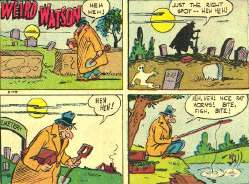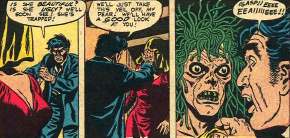"(GASP!) EEEE EEAIIIIIEEE!!"

from Adventures into Darkness #14 (April 1954)
Someday I’d like to see a collection of all the space-filling short humor strips used to fill out comics back in the day. Also…was this Weird Watson’s only appearance? How can you not love that guy?
What fresh hell is this? Weekly World News…shutting down? Bat Boy…homeless? Ed Anger…even angrier?
Weekly World News has had several connections to the comic book world, such as editors Paul Kupperburg and Bob Greenberger, writer Andy Mangels, and, of course, Peter Bagge’s run of initial “Bat Boy” comic strips, among others.
The supermarket just won’t be the same without Weekly World News staring back out at you at the checkout line. Another little piece of Americana slips away.
(First spotted via Metafilter.)
A couple more follow-up questions from the ’90s bust discussion:
- Commenter Phil asks
“One thing I’ve started wondering about your memories of the speculative boom – how much cash would your average collector buying multiple copies for investment value actually have sent down the toilet, in terms of purchase price versus current value?”
That’s a hard question to answer. Well, maybe not…the general response would be “a lot,” but it would depend really on what multiple copies they purchased (and assuming they kept them in sellable shape, which, as I noted Friday, was rarely the case).
But even if they did end up investing in a boom-era comic book with some current demand and a reasonable aftermarket price — say, for example, Spawn #1 — is the 30% to 50% (if you’re lucky) of that aftermarket price you’re going to get by selling it to a dealer, or on eBay, worth the fifteen years you’ve stored them? And if you have a lot of them, you might run into the problem I mentioned here…you might be able to sell 5 or 10 or even 20 copies of Spawn #1 to the same buyer, but it’s not likely you’ll be able to sell a full case of a couple hundred copies to that buyer. At least, not without taking an enormous loss on them. I can use some Spawn #1s for the shop, but I’m not going to tie up a lot of money in 200 copes that might take me a decade or more to sell. If you want me to buy a full case of Spawn #1, it better be cheap.
And if you’ve got something nobody wants, like, say, Brigade #1, you’ve gone from the “you may make a little bit of your money back” situation with Spawn to the “too bad it’s not soft enough to use as toilet paper” side of things. Sure, the price guide might say it’s worth cover price or so, but they’re not actually selling for that. To anyone. Ever. They’re not even selling in our bargain bins, much less at full price. Anyone who invested in Brigade will find themselves…well, I believe the technical term is “losing one’s ass.”
Speaking of asses and the loss thereof…another thing to consider, when it comes to value of many of the boom books…some of you folks may remember that our shop was clearing out some backstock, selling about 100,000 units to somebody who needed comic books in bulk, regardless of title or publisher. We unloaded tons of ’90s crash-era comics at the princely sum of one shiny nickel per funnybook. Alas, I doubt you’ll see that pricing reflected in the listings of your favorite price guide (“SECOND LIFE OF DR. MIRAGE #1 – $0.05 in NM condition”).
So, anyway, to actually answer the question: while I’m sure there are some success stories, the vast majority of people who invested in multiple copies probably only realized pennies for each dollar spent, if even that.
- Commenter Mathew has a question about something a little more recent:
“Do you think 52 would have sold as well if DC published it as a monthly trade rather than a weekly pamphlet?”
If they had gone the monthly paperback route, 52 would have been a drastically different creature. (For one, they would have called it 12.) It was designed as a weekly serial, with cliffhangers, and its impact (and novelty) would have been diminished had it been yet another monthly publication. Not saying there isn’t room for DC to experiment with a superhero story serialized as a monthly trade paperback, but 52 was primarily designed to take advantage of the weekly new comic pamphlet release schedule, which contributed to its sale success.
Another good sequence from Adventures into Darkness #14:








